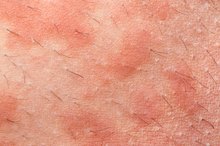What does fact checked mean?
At Healthfully, we strive to deliver objective content that is accurate and up-to-date. Our team periodically reviews articles in order to ensure content quality. The sources cited below consist of evidence from peer-reviewed journals, prominent medical organizations, academic associations, and government data.
- MayoClinic.com: Slide Show: Common Skin Rashes: Drug Rash
- MayoClinic.com: Atopic Dermatitis (Eczema)
The information contained on this site is for informational purposes only, and should not be used as a substitute for the advice of a professional health care provider. Please check with the appropriate physician regarding health questions and concerns. Although we strive to deliver accurate and up-to-date information, no guarantee to that effect is made.
Red Itchy Skin Around the Nose
Dry, itchy skin in the winter is a problem many people experience. Cold temperatures can wreak havoc on your skin and exacerbate any existing skin conditions. The skin around the nose is particularly sensitive, especially if you have a cold and are constantly blowing or wiping your nose. However, chronic red itchy skin around the nose could indicate a treatable skin condition such as eczema or atopic dermatitis, or another form of dermatitis known as seborrhea 16.
Identification
Dermatitis, also known as eczema, is a term used to describe a variety of skin conditions characterized by a red itchy rash where the upper layers of the skin become inflamed 6.
According to the American Academy of Dermatology, or AAD, there are nine types of dermatitis, with atopic being the most common 16. Atopic dermatitis affects 10 percent to 20 percent of the world's population, and without treatment and continued scratching, the skin will thicken to protect itself, a process dermatologists refer to as lichenification 16. Ninety percent of sufferers will develop the condition by age 5 and dermatitis is often familial, occurring in more than one family member.
Seborrheic dermatitis, or seborrhea, is normally found on the scalp but can spread to the face and develop in and around the nose 4. If the red itchy skin around your nose is seborrhea, it will be accompanied by flaking skin with a scale that can turn anywhere from white to yellowish brown.
- Dermatitis, also known as eczema, is a term used to describe a variety of skin conditions characterized by a red itchy rash where the upper layers of the skin become inflamed 6.
- Seborrheic dermatitis, or seborrhea, is normally found on the scalp but can spread to the face and develop in and around the nose 4.
Effects
How to Reduce Keratin
Learn More
The exact cause of dermatitis is not known, but researchers have pinpointed a number of factors and probable causes, including an overactive immune system, your genetic makeup and overall general health. Researchers have also identified a skin barrier defect or gaps in the skin that allow germs to penetrate the upper layers causing inflammation.
People who suffer from dermatitis are prone to other allergic conditions such as asthma and hay fever. You also can develop contact dermatitis as a reaction to an irritant of some kind like soap, laundry detergent, perfume or cosmetics. In this particular case, if you can identify the irritant and remove it, the red itchiness around your nose should resolve on its own in two to three weeks.
Seborrheic dermatitis is thought to occur when a number of different factors interact 4. These factors can include the climate in which you live -- as people living in northern states are more likely to suffer from the condition -- stress levels and yeast, which normally lives on your skin.
- The exact cause of dermatitis is not known, but researchers have pinpointed a number of factors and probable causes, including an overactive immune system, your genetic makeup and overall general health.
- These factors can include the climate in which you live -- as people living in northern states are more likely to suffer from the condition -- stress levels and yeast, which normally lives on your skin.
Considerations
If you're experiencing chronic red itchy skin around your nose, a trip to the dermatologist or your family physician may be in order. Diagnosing your exact kind of dermatitis can be challenging because many of them present with the same symptoms. A visual examination with a complete medical history is usually all it takes to diagnose both atopic and seborrheic dermatitis, although on occasion a skin biopsy is necessary to rule out other medical conditions 146. And while there is no cure for dermatitis, it can be effectively treated.
- If you're experiencing chronic red itchy skin around your nose, a trip to the dermatologist or your family physician may be in order.
Treatment
Dry Flaking on the Nose
Learn More
To successfully manage dermatitis, a multifaceted approach is necessary. Your doctor can prescribe a topical corticosteroid cream to reduce inflammation and control itching. Seborrhea may require a topical anti-fungal agent applied to the affected areas. In some cases, if the dermatitis is more severe, exposure to ultraviolet light is advised under the direction of a physician and in a controlled office environment. However, this treatment is not recommended for children because of potential long-term side effects.
To help control flare-ups, you should try to avoid known triggers such as rapid changes in temperature, excessive sweat on the skin and stress. Keeping a diary of when breakouts occur may help identify your particular triggers.
- To successfully manage dermatitis, a multifaceted approach is necessary.
- Seborrhea may require a topical anti-fungal agent applied to the affected areas.
Benefits
There are many things you can do on your own at home to help alleviate some of the symptoms of dermatitis. Avoid scratching the area around your nose and apply a cold compress to help protect the skin. When buying a soap to wash your face, choose one that is classified as mild and contains no dyes or perfumes. Make sure the soap is rinsed completely from your face. Moisturize the area around your nose frequently and apply the cream while your face is still wet to seal in the moisture. You may also want to consider buying a humidifier, which adds moisture into the air, as hot, dry indoor air will only exacerbate the itching.
- There are many things you can do on your own at home to help alleviate some of the symptoms of dermatitis.
- Moisturize the area around your nose frequently and apply the cream while your face is still wet to seal in the moisture.
Related Articles
References
- EczemaNet: Atopic Dermatitis
- EczemaNet: What Is Eczema?
- MayoClinic.com: Slide Show: Common Skin Rashes: Drug Rash
- EczemaNet: Seborrheic Dermatitis
- The Merck Manuals Online Medical Library: Dermatitis
- MayoClinic.com: Atopic Dermatitis (Eczema)
- Owen JL, Vakharia PP, Silverberg JI. The role and diagnosis of allergic contact dermatitis in patients with atopic dermatitis. Am J Clin Dermatol. 2018;19(3):293-302. doi:10.1007/s40257-017-0340-7
- Fonacier L, Bernstein DI, Pacheco K, et al. Contact dermatitis: a practice parameter-update 2015. J Allergy Clin Immunol Pract. 2015;3(3 Suppl):S1-39. doi:10.1016/j.jaip.2015.02.009
- Thomsen SF. Atopic dermatitis: Natural history, diagnosis, and treatment. ISRN Allergy. 2014; 2014:354250. doi:10.1155/2014/354250
- National Institute for Occupational Safety and Health. Poisonous plants. Updated June 1, 2018.
- Chopra R, Vakharia PP, Sacotte R, Silverberg JI. Efficacy of bleach baths in reducing severity of atopic dermatitis: A systematic review and meta-analysis. Ann Allergy Asthma Immunol. 2017;119(5):435-440. doi:10.1016/j.anai.2017.08.289
- Maarouf M, Shi VY. Bleach for atopic dermatitis. Dermatitis. 2018;29(3):120-126. doi:10.1097/DER.0000000000000358
Writer Bio
Krystal Simpson has been working as a freelance writer since 1998, focusing on topics related to health care. She's written patient materials for various cancer organizations and her articles have appeared in "Our Voice" and "The Navigator." She holds a Master of Arts in journalism from Northeastern University and currently resides in Canada.









